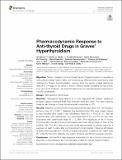Files in this item
Pharmacodynamic response to anti-thyroid drugs in Graves’ hyperthyroidism
Item metadata
| dc.contributor.author | Abbara, Ali | |
| dc.contributor.author | Clarke, Sophie | |
| dc.contributor.author | Brewster, Rosalind | |
| dc.contributor.author | Simmonard, Alexia | |
| dc.contributor.author | Eng, Pei Chia | |
| dc.contributor.author | Phylactou, Maria | |
| dc.contributor.author | Papadopoulou, Deborah | |
| dc.contributor.author | Izzi-Engbeaya, Chioma | |
| dc.contributor.author | Sam, Amir | |
| dc.contributor.author | Jonauskyte, Eliza | |
| dc.contributor.author | Comninos, Alexander | |
| dc.contributor.author | Meeran, Karim | |
| dc.contributor.author | Kelsey, Tom | |
| dc.contributor.author | Dhillo, Waljit | |
| dc.date.accessioned | 2020-05-13T11:30:04Z | |
| dc.date.available | 2020-05-13T11:30:04Z | |
| dc.date.issued | 2020-05-12 | |
| dc.identifier | 267500867 | |
| dc.identifier | 1c312a58-4762-48dc-a79e-3acb45ffad72 | |
| dc.identifier | 000537287700001 | |
| dc.identifier | 85085382439 | |
| dc.identifier.citation | Abbara , A , Clarke , S , Brewster , R , Simmonard , A , Eng , P C , Phylactou , M , Papadopoulou , D , Izzi-Engbeaya , C , Sam , A , Jonauskyte , E , Comninos , A , Meeran , K , Kelsey , T & Dhillo , W 2020 , ' Pharmacodynamic response to anti-thyroid drugs in Graves’ hyperthyroidism ' , Frontiers in Endocrinology , vol. 11 , 286 . https://doi.org/10.3389/fendo.2020.00286 | en |
| dc.identifier.issn | 1664-2392 | |
| dc.identifier.other | ORCID: /0000-0002-8091-1458/work/74117899 | |
| dc.identifier.uri | https://hdl.handle.net/10023/19930 | |
| dc.description | The Section of Endocrinology and Investigative Medicine was funded by grants from the MRC, BBSRC, NIHR, an Integrative Mammalian Biology (IMB) Capacity Building Award, an FP7- HEALTH- 2009- 241592 EuroCHIP grant and was supported by the NIHR Biomedical Research Centre Funding Scheme. AA was supported by an NIHR Clinician Scientist award. SC was supported by an NIHR Clinical Lectureship. AC was supported by the NHS and BRC. WD was supported by an NIHR Research Professorship (RP-2014-05-001). | en |
| dc.description.abstract | Objective: Graves' disease is the commonest cause of hyperthyroidism in populations with sufficient dietary iodine intake. Anti-thyroid drugs (ATD) are often used as the initial treatment for Graves' hyperthyroidism, however there is a paucity of data relating the dose of ATD therapy to the effect on thyroid hormone levels, increasing the risk of both over- and under-treatment. We aimed to determine the pharmacodynamic response to the ATD carbimazole. Design: Retrospective cohort study. Methods: Participants were patients (n = 441) diagnosed with Graves' disease at Imperial College Healthcare NHS Trust between 2009 and 2018. The main outcome measure was change in thyroid hormone levels in response to ATD. Results: Baseline thyroid hormone levels were positively associated with TSH receptor antibody titres (P < 0.0001). Baseline free triiodothyronine (fT3) were linearly related to free thyroxine (fT4) levels in the hyperthyroid state (fT3 = fT4*0.97–11), and fell proportionately with carbimazole. The percentage falls in fT4 and fT3 per day were associated with carbimazole dose (P < 0.0001). The magnitude of fall in thyroid hormones after the same dose of carbimazole was lower during follow up than at the initiation visit. The fall in thyroid hormone levels approximated to a linear response if assessed at least 3 weeks after commencement of carbimazole. Following withdrawal of antithyroid drug treatment, the risk of relapse was greater in patients with higher initial fT4, initial TSH receptor antibody titre, males, smokers, and British Caucasian ethnicity. Conclusion: We identify a dose-response relationship for fall in thyroid hormones in response to carbimazole to aid in the selection of dose for Graves' hyperthyroidism. | |
| dc.format.extent | 11 | |
| dc.format.extent | 797836 | |
| dc.language.iso | eng | |
| dc.relation.ispartof | Frontiers in Endocrinology | en |
| dc.subject | Graves‘ disease | en |
| dc.subject | Anti-thyroid drug (ATD) | en |
| dc.subject | Carbimazole | en |
| dc.subject | Hyperthyroidism | en |
| dc.subject | Anti-thyroid drug therapy | en |
| dc.subject | RC Internal medicine | en |
| dc.subject | RM Therapeutics. Pharmacology | en |
| dc.subject | NDAS | en |
| dc.subject.lcc | RC | en |
| dc.subject.lcc | RM | en |
| dc.title | Pharmacodynamic response to anti-thyroid drugs in Graves’ hyperthyroidism | en |
| dc.type | Journal article | en |
| dc.contributor.institution | University of St Andrews. School of Computer Science | en |
| dc.contributor.institution | University of St Andrews. Centre for Interdisciplinary Research in Computational Algebra | en |
| dc.identifier.doi | 10.3389/fendo.2020.00286 | |
| dc.description.status | Peer reviewed | en |
This item appears in the following Collection(s)
Items in the St Andrews Research Repository are protected by copyright, with all rights reserved, unless otherwise indicated.

